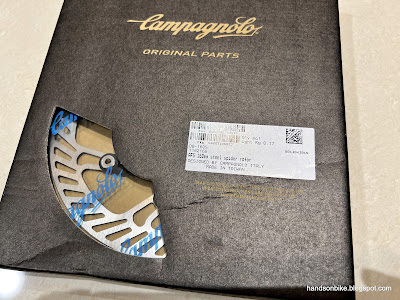The Campagnolo Ekar is a gravel specific groupset, which means that it comes with hydraulic disc brakes. In the previous post, the Ekar shifters were introduced. In this post, I will share more details on the Ekar hydraulic brake calipers and disc rotor.
These brake calipers come as a set with the shifters, with the hydraulic oil already inside the shifters, hose and brake caliper. Theoretically, if you connect everything up properly, there is no need to bleed the hydraulic system. The concept is the same as the Shimano J-kit, but the execution method is different.
On the Shimano J-kit system, the hose is connected to the brake caliper, while on this Campagnolo Ekar system, the hose is connected to the shifters.
Campagnolo Ekar hydraulic brake caliper for Flat Mount, looks good to me! The yellow plug is to keep the hydraulic oil in.
Disc brake pads are loaded from the top, and secured by a bolt and clip, similar to Shimano brakes.
Plain appearance on the inside. The sandblasted texture looks good.
Lots of information on the bottom of the brake caliper. Nice to see the recommended torque value conveniently located.
Each brake caliper weighs 127 grams, including the oil and brake pad. Similar to an Ultegra brake caliper I think.
Strange that the brake caliper comes with the brake pad completely closed, unlike the Shimano ones that come with a bleed block and no brake pads inside.
When connecting hydraulic parts, it is always a good idea to put the brake pads far away from any potential oil leak or splash. On Shimano brakes, this is not a problem as the brake pads are packed separately from the brake caliper.
However, on this Campagnolo Ekar brakes, I will prefer to first remove the brake pads before connecting the hydraulic hose. After that, once the brake calipers are bolted to the frame, I will need to manually open up the brake pistons before the rotor and wheel can be slotted into the frame.
The official assembly method that Campagnolo suggests is to connect the hose to the brake caliper, then use a tool to pry open the brake pads.
To complete the set, I chose Campagnolo disc brake rotors as well. They are not Ekar specific, and can be used for other brands or systems as well.
160 mm rotors will be used both at the front and rear.
Well packaged, similar to Shimano rotors.
The design of the rotor is quite attractive, with evenly distributed slots all around the perfectly circular disc. The 7 sided spider is an interesting design choice as well.
The stainless steel braking surface is riveted to the steel spider using hollow rivets.
Centerlock profile is stamped out of the steel spider which is no easy feat.
Rotor thickness is 1.8 mm which should fit most hydraulic brake calipers.
Each rotor weighs 157 grams which is quite heavy. Same weight as the Shimano RT64 rotor.
It is unfortunate that Campagnolo chose to use a steel spider instead of an aluminium spider, as this increases the weight by a lot. An aluminium spider would save at least 30 grams and make it more competitive against other rotors. I like this Campagnolo rotor design but not the weight, as a XTR or Deore XT rotor is much lighter at just 106 grams for a 160 mm rotor.













No comments:
Post a Comment
Every comment is moderated before publishing due to spam bots. If you don't see your comment yet, it is likely that it is currently being reviewed. Thank you for your patience!